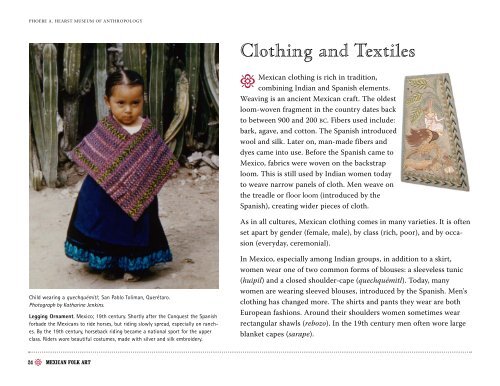Mexican Folk Art - Home
Mexican Folk Art - Home
Mexican Folk Art - Home
Create successful ePaper yourself
Turn your PDF publications into a flip-book with our unique Google optimized e-Paper software.
PHOEBE A. HEARST MUSEUM OF ANTHROPOLOGY<br />
Child wearing a quechquémitl; San Pablo Toliman, Querétaro.<br />
Photograph by Katharine Jenkins.<br />
Legging Ornament. Mexico; 19th century. Shortly after the Conquest the Spanish<br />
forbade the <strong>Mexican</strong>s to ride horses, but riding slowly spread, especially on ranches.<br />
By the 19th century, horseback riding became a national sport for the upper<br />
class. Riders wore beautiful costumes, made with silver and silk embroidery.<br />
24 � MEXICAN FOLK ART<br />
Clothing and Textiles<br />
�<br />
<strong>Mexican</strong> clothing is rich in tradition,<br />
combining Indian and Spanish elements.<br />
Weaving is an ancient <strong>Mexican</strong> craft. The oldest<br />
loom-woven fragment in the country dates back<br />
to between 900 and 200 BC. Fibers used include:<br />
bark, agave, and cotton. The Spanish introduced<br />
wool and silk. Later on, man-made fibers and<br />
dyes came into use. Before the Spanish came to<br />
Mexico, fabrics were woven on the backstrap<br />
loom. This is still used by Indian women today<br />
to weave narrow panels of cloth. Men weave on<br />
the treadle or floor loom (introduced by the<br />
Spanish), creating wider pieces of cloth.<br />
As in all cultures, <strong>Mexican</strong> clothing comes in many varieties. It is often<br />
set apart by gender (female, male), by class (rich, poor), and by occasion<br />
(everyday, ceremonial).<br />
In Mexico, especially among Indian groups, in addition to a skirt,<br />
women wear one of two common forms of blouses: a sleeveless tunic<br />
(huipil) and a closed shoulder-cape (quechquémitl). Today, many<br />
women are wearing sleeved blouses, introduced by the Spanish. Men's<br />
clothing has changed more. The shirts and pants they wear are both<br />
European fashions. Around their shoulders women sometimes wear<br />
rectangular shawls (rebozo). In the 19th century men often wore large<br />
blanket capes (sarape).


